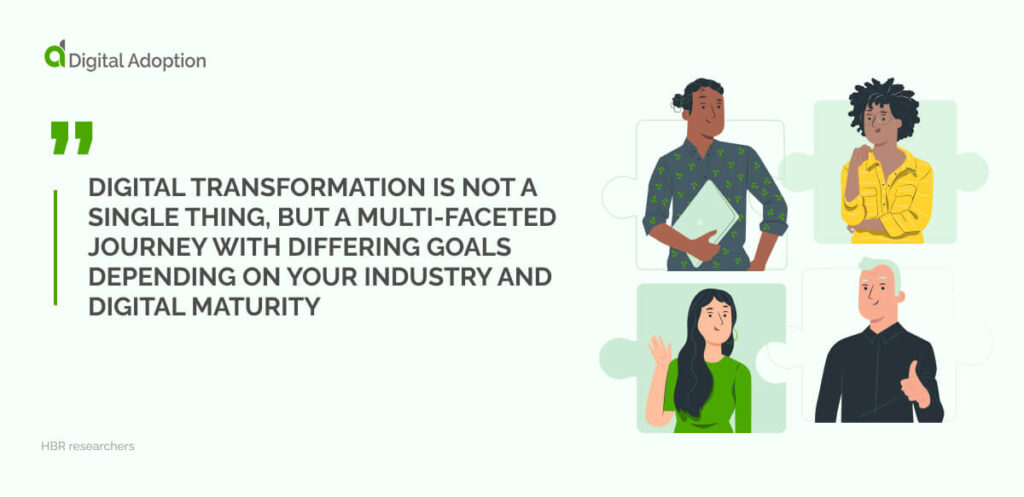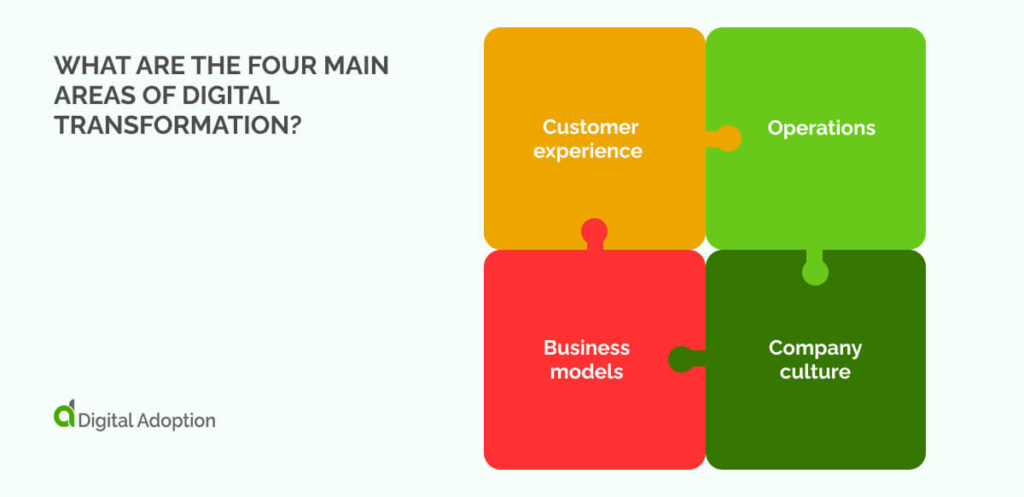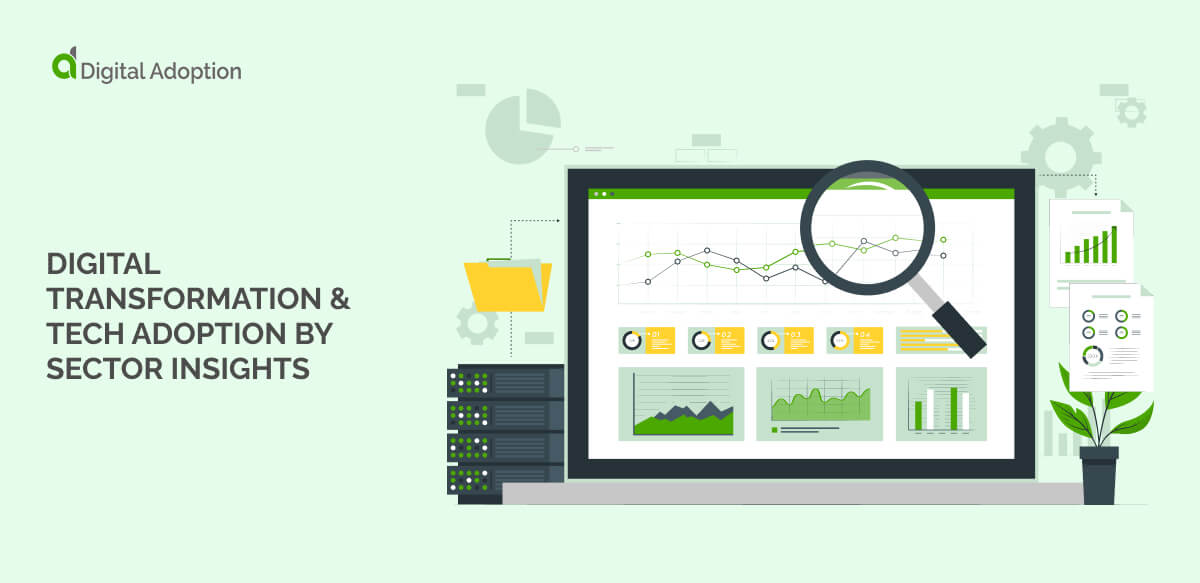Rising tech adoption and the need for future-ready strategies are triggering a sector-wide digital transformation.
Spurred on by a revolving door of new and emerging technology, these transformations create new value and drive business innovation. This accessibility gives organizations across industries the resources to expand their scope in an increasingly digital world.
Those objectives will look entirely different depending on the needs of each company or sector. HBR researchers state, “Digital transformation is not a single thing, but a multi-faceted journey with differing goals depending on your industry and digital maturity.”

This article will explore digital transformation by sector. It will provide a sector-by-sector observation of how technology impacts key business processes and how these changes differ depending on the field.
- 1. Digital transformation in education
- 2. Digital transformation in higher education
- 3. Digital transformation in construction
- 4. Digital transformation in engineering
- 5. Digital transformation in oil and gas
- 6. Digital transformation in manufacturing
- 7. Digital transformation in life sciences
- 8. Digital transformation in pharma
- 9. Digital transformation in logistics
- 10. Supply chain digital transformation
- 11. Digital transformation in retail
- 12. Digital transformation in fashion
- 13. Digital transformation in hospitality
- 14. Airline digital transformation
- 15. Digital transformation in marketing
- What’s next for digital transformation?
- People Also Ask
1. Digital transformation in education
Digital transformation in education is opening up new ways to learn and grow.
At its core, EdTech makes learning easier through online tools like video calls and collaboration platforms. Students and teachers use programs like Zoom, Microsoft Teams, and Google Workspace to stay connected and share resources.
Exciting advancements in EdTech also include virtual reality (VR) and augmented reality (AR), which are changing how lessons are taught. With mixed reality (MR), teachers can add helpful virtual features to classrooms, making complex ideas, like math equations, easier to understand and interact with using VR, improving engagement and learning outcomes.
2. Digital transformation in higher education
Digital transformation in higher education encourages traditional schools to invest in new technology that improves teaching and learning.
This includes online courses, digital platforms like Moodle and Canvas, and student portals like Blackboard for easy resource access. AI is changing admin tasks, with chatbots offering 24/7 help for students.
These chatbots provide support with questions and course guidance, while virtual classrooms are becoming more popular, making lessons more engaging. However, the extent of these changes varies from school to school, depending on their budget and willingness to adopt new technology for teaching and administration.
3. Digital transformation in construction
Digital transformation in construction is helping companies work faster and smarter. New technologies are helping them keep up with changes in manufacturing and eCommerce. As clients ask for more, these tools help companies meet expectations and improve their work.
Technology is improving key parts of construction, like project management, communication, and operations. Digital tools help companies stay on track, reduce mistakes, and finish projects faster.
Digital tools are used at every step of a project, from its start to its completion. These tools help make construction work more efficient and reduce delays, making the whole process run more smoothly.
4. Digital transformation in engineering
Digital transformation in engineering aims to enhance processes and efficiency by incorporating digital technology into every business element.
For example, construction companies use 3D modeling and drones for design and site surveys. These tools replace manual methods, making work more efficient and precise. AI tools address specific problems. AI-powered scheduling predicts project timelines by factoring in weather, labor, and material availability.
Combined with AR and VR, AI helps workers see tasks more clearly. AI copilots give step-by-step guidance through mixed-reality devices, allowing workers to follow instructions, learn faster, and reduce errors in training.
5. Digital transformation in oil and gas
Digital transformation in oil and gas is improving safety and efficiency. IoT sensors and AI monitor equipment in real time, preempting future issues. This helps avoid costly breakdowns and reduces downtime.
Cloud systems let teams share data quickly, speeding up decision-making and boosting collaboration. Drones and robots now handle inspections in hard-to-reach or dangerous spots, lowering the risk for workers.
Virtual and augmented reality are changing training. Workers can practice tasks in a safe, virtual environment. These technologies help improve skills, reduce mistakes, and make the industry safer and more efficient.
6. Digital transformation in manufacturing
Digital transformation in manufacturing involves adopting new digital technologies to enhance the entire manufacturing process.
For example, robotic process automation (RPA) helps with routine tasks, allowing workers to focus on more important jobs. Mobile apps give managers real-time data to make faster decisions.
3D printing speeds up prototype creation and reduces waste. Digital twins create virtual models of equipment so managers can track performance in real time. AI-powered sensors can predict when equipment is about to break down so it can be fixed before problems happen.
7. Digital transformation in life sciences
Digital transformation in life sciences is improving, but it’s been slower than in other industries.
For example, AI helps speed up drug discovery by analyzing large amounts of data. Wearable devices collect real-time health data from patients and help researchers. Automation replaces manual work in labs, making everything faster and more accurate.
However, challenges like differences between equipment makers and healthcare providers slow progress. Privacy concerns and legal issues also create problems. Despite these, life sciences are catching up, making drug development faster and clinical trials more efficient. This progress leads to quicker treatments and better results for patients.
8. Digital transformation in pharma
Digital transformation in pharma is improving the way medicine is created and used. New technology like AI helps scientists discover new drugs faster by analyzing large amounts of data.
Robots and machines help make medicines more accurate and reduce mistakes. Digital tools also help doctors track their patients’ health, making it easier to give the right care. Virtual platforms allow doctors and patients to talk easily, even if they’re far apart.
These changes help reduce costs, improve patient care, and speed up the time it takes to develop new medicines. This leads to better healthcare for the general population at a reduced overall cost.
9. Digital transformation in logistics
Digital transformation in logistics is changing how goods are delivered and tracked. With technologies like IoT (Internet of Things), AI, and automation, logistics has become faster and more efficient.
IoT sensors give real-time updates on things like inventory and delivery progress, helping companies make better decisions. AI helps find the quickest routes for deliveries, saving time and money.
Automation, like drones and robots, speeds up warehouse work, reducing mistakes. These digital tools also help businesses stay in touch with suppliers, drivers, and customers, making the whole system run smoother and faster.
10. Supply chain digital transformation
Supply chain digital transformation alters how companies manage product movement from start to finish. With technologies like AI, IoT, and blockchain, businesses can track goods more accurately and make smarter decisions.
IoT sensors help monitor shipments in real time so companies know where products are at all times. AI tools help manage stock levels, reduce waste, and ensure on-time deliveries. Blockchain adds an extra layer of security by tracking products’ journeys.
These technologies make supply chains faster, more efficient, and able to meet customer needs more effectively.
11. Digital transformation in retail
Digital transformation in retail is revising traditional store operations. Online shopping platforms let people buy from anywhere, while apps and websites recommend products based on past purchases.
Stores use tech like self-checkout machines to speed things up, and augmented reality lets customers try products virtually. These new technologies make shopping faster, easier, and more personalized, giving customers what they want and making stores more efficient.
Retailers use these changes to keep up with consumer expectations, improve customer experiences, and stay competitive, ultimately increasing their sales and reaching a wider audience.
12. Digital transformation in fashion
Digital transformation in fashion is reshaping how brands design, produce, and sell clothes. Online shopping platforms make it easier for customers to browse and buy from anywhere, while social media and influencer marketing help brands connect with a wider audience.
Virtual try-ons using augmented reality let customers see how clothes will look on them without trying them on. In production, 3D printing and AI-powered designs help create clothing faster and more efficiently.
These changes are not only making fashion more accessible and personalized but also driving sustainability by reducing waste and improving supply chain management. Fashion is becoming smarter and faster.
13. Digital transformation in hospitality
Digital transformation in hospitality is improving how hotels, restaurants, and travel services work to make things easier and better for customers. With the help of mobile apps, online booking, and smart technology, guests can have a more convenient experience.
AI chatbots answer questions anytime, and automation speeds up services. Staff can use data to understand what guests like, giving them a more personalized stay. These changes help businesses run more smoothly, making customers happier.
As technology continues to grow, the hospitality industry can offer even more customized experiences to meet the needs of all guests.
14. Airline digital transformation
Airline digital transformation is making flying easier and more efficient. Technology like online booking, mobile check-ins, and AI help airlines manage flights and pricing. Passengers can enjoy better services, like Wi-Fi and entertainment, during their flights.
Automation is used to improve things like baggage handling and security. These changes make flying faster, cheaper, and more convenient, improving the overall experience for travelers.
Using new technology enables airlines to save money, work more efficiently, and meet the needs of passengers who expect more from their travel experience.
15. Digital transformation in marketing
Digital transformation in marketing is drastically changing how businesses reach customers. Tools like targeted social media, email, and data, help companies send messages that matter to the right people.
AI predicts customer needs and creates custom ads. Social media lets businesses talk directly to customers, building trust. Automation makes tasks like sending emails easier. Data also helps track success and make plans more useful.
This transformation makes marketing more efficient and personal, helping businesses connect with customers in new, more effective ways. It also saves time, letting teams focus on big-picture strategies to grow their brand.
What’s next for digital transformation?
Digital transformation is reconfiguring industries worldwide, and its impact is clear.
New technologies are shaping sectors like education, healthcare, manufacturing, and retail. Companies that welcome these changes are more likely to adapt, grow, and outmanouvre the competition.
While digital transformation is bound to happen, industries that stay agile will be better at creating new opportunities and leading the way. It’s not just about using technology, but using it wisely to improve processes and meet customer needs.
Digital transformation is essential for industries to succeed in the future. Investing in the right tools and skills means businesses stay relevant, improve efficiency, and build a future-proof digital transformation roadmap.
The key to success is to embrace change now because tomorrow belongs to those who act now.

People Also Ask
-
Which sector performs best in digital transformation?The tech and retail sectors are leading in digital transformation. They use new technologies like AI and automation to improve customer service, sales, and operations. These industries are quick to adapt, which helps them stay competitive in the fast-changing digital world.
-
What is the biggest obstacle to digital transformation?The biggest obstacle to digital transformation is resistance to change. People might be unwilling to try new technologies or ways of working. Without clear direction and support, businesses struggle to adopt new tools and processes, slowing progress.
-
What are the four main areas of digital transformation?The four main areas are: Customer experience Operations Business models Company culture These areas focus on improving businesses interactions with customers, making their operations more efficient, creating new ways to earn money, and encouraging a mindset of change and innovation within the company.









